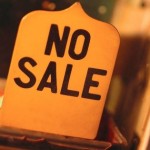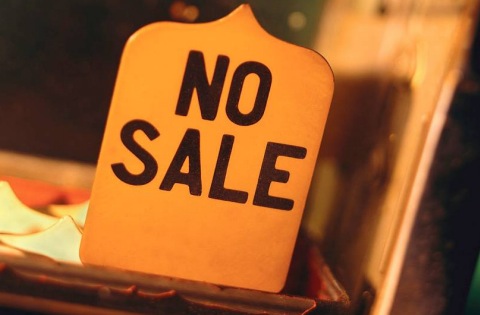01 Nov 2013
3 Signs You Are About To Lose The Sale
 Like most of you, I get cold calls and e-mails every day. 98% of it is spam – offers for things I have no interest in, or don’t need. Only 2% are even relevant to me or my business and unfortunately, most of those don’t get my attention either (so they inadvertently lose the sale).
Like most of you, I get cold calls and e-mails every day. 98% of it is spam – offers for things I have no interest in, or don’t need. Only 2% are even relevant to me or my business and unfortunately, most of those don’t get my attention either (so they inadvertently lose the sale).
Truth be told, I almost never answer or respond and I’m sure you feel the exact same way. It’s not because I have it in for salespeople – although most of us will admit we cringe at the hard sell tactics of the stereotypical salesperson. It’s because the vast majority of salespeople completely blow their initial approach and fail to capture my interest.
Now I appreciate and respect the fact that these people are just trying to do their jobs and make a living. Selling is not a crime. In fact, we are ALL in the business of selling something – a product, a service, an idea, a lifestyle, a belief, or a cause. So, like you, I’m not insensitive to the plight of the honest, hardworking sales professional.
The problem is this – most of their hard work (and yours) often goes to waste when they lose the sale for reasons that are preventable. They end up turning me off their product or whatever it is they’re selling because I am either bored, confused or overwhelmed by the pitch. And this usually shows up in one of three classic responses that I give, which I’m sure you have heard (or given) before. These are telltale cues that they (or you) are about to lose the sale:
- This isn’t a good time for me,
- I need to think about it, or
- Leave it with me and I will go over it later.
Fortunately, the mistakes that produced these 3 classic responses are completely avoidable – mistakes that you don’t have to make (and lose the sale) once you discover how the brain of your prospect hears your message and what you need to do to help him make a decision quickly.
The first and most important step in creating a sales or marketing message that closes more business is to become an expert at capturing attention up-front. If you are successful at quickly and strongly enchanting your prospect within the first 60 seconds, you stand a much greater chance of holding his interest until you can communicate your entire message.
Regardless of the length of your sales presentation or marketing message, you must capture attention and deliver your most powerful points up-front when your audience is most alert and receptive. Never begin by introducing your brand, building your credibility, talking about your competitors, or listing features and benefits. This strategy will put your customers to sleep (cause you to lose the sale) and you risk having to deliver your most important claims and proof when your customers are least likely to remember them.
In order to capture the attention of your audience and hold it, you have to know the one thing that is MOST important to them right now. This is something that you cannot afford to guess or assume. In order to make the greatest impact and charm the old brain of your customer, you need to do your homework up-front. You can’t afford the luxury of pitching five or six features/benefits and hope that one of them will appeal or hit the mark.
By taking the time upfront to help your prospect understand, acknowledge, and quantify his #1 source of pain, he will become clear about the true source and intensity of this problem, and you will reinforce (with his old brain) that it is safe to trust you and your proposed solution. Failing to do so, will inevitably lead to the undesired result of causing you to lose the sale and waste your valuable time and money in the process.
 Although you may like to think you are creatively captivating your consumer with your communications, allow me to drop a mind-blowing bomb… Did you know that your current marketing messages are falling on the deaf ears of approximately 98% of your prospects?
Although you may like to think you are creatively captivating your consumer with your communications, allow me to drop a mind-blowing bomb… Did you know that your current marketing messages are falling on the deaf ears of approximately 98% of your prospects?
Read More
 If there’s one difficult experience that every sales or marketing professional has been through at least once, it’s that sinking sensation that comes when a campaign you really poured your heart and soul into just doesn’t hit the mark, for reasons you don’t completely understand. Naturally, you wonder if it was something obvious that you missed – like a spelling error or a grammatical snafu? Maybe you didn’t include enough information? Or your call to action just wasn’t compelling enough?
If there’s one difficult experience that every sales or marketing professional has been through at least once, it’s that sinking sensation that comes when a campaign you really poured your heart and soul into just doesn’t hit the mark, for reasons you don’t completely understand. Naturally, you wonder if it was something obvious that you missed – like a spelling error or a grammatical snafu? Maybe you didn’t include enough information? Or your call to action just wasn’t compelling enough?
Read More
 Imagine you’re the CEO of an established private healthcare business when the economy plunges into the worst downturn since the Great Depression. Up to then, your team has delivered extraordinary results; your bottom line is growing steadily each year and your services are recognized as world class by the hospitals, city councils and large public health facilities that refer work to you.
Imagine you’re the CEO of an established private healthcare business when the economy plunges into the worst downturn since the Great Depression. Up to then, your team has delivered extraordinary results; your bottom line is growing steadily each year and your services are recognized as world class by the hospitals, city councils and large public health facilities that refer work to you.
Imagine choosing that time to tell your Board and senior management team that, in essence, you want to walk away from about half of that business and pursue a very narrow niche market.
No doubt, you may at this point be imagining yourself out of a job. But hear me out…
As you may have guessed, this story is not a fictional one and the “you” in the story is actually a business coaching client of mine. I’m happy to report that the discussion with the Board went quite well, the business has nearly doubled since that day, and my client is still the CEO.
And along the way we both learned some valuable lessons about how to increase sales and become the dominant player in the marketplace. In fact, there is a big difference between being just a good company and being one that your customers can’t live without.
Solve Your Customer’s #1 Source of Pain
Consumer sentiment and spending have decreased dramatically in the past few years and those changes are being felt across every industry. Everything you thought you knew about your customer and why he/she was buying from you has probably changed. And if you do not take the time now to re-discover your prospect’s main source of pain and the reason why she needs your product or service now, you will never increase sales. In fact, you risk losing more sales and more ground to your competition.
Now some of you may think – but my industry is different
 Not that long ago, I received a 15-page sales letter from a self-proclaimed small business marketing expert trying to convince me to attend his latest seminar. I was actually blown away at how bad the letter was… and how mind numbing.
Not that long ago, I received a 15-page sales letter from a self-proclaimed small business marketing expert trying to convince me to attend his latest seminar. I was actually blown away at how bad the letter was… and how mind numbing.
Part of what struck me as both humorous and shocking was that he claimed to be an expert in neuromarketing (and small business marketing). Ironically, there is a vast amount of neuroscientific research that proves the average human attention span is incredibly short and that all decisions are dominated by the oldest and most primitive part of the brain – the old or reptilian brain.
So if the decision-making part of your brain is incredibly hasty and primarily driven by survival instincts, what are the chances that either you or I would wade through 15 pages of self-indulgent copy to decide whether or not we want to attend a seminar? Odds are slim, aren’t they?
What Do Successful Small Business Marketing Professionals Do to Compel Prospects to Say “Yes”?
If you are interested in more articles to help you boost the effectiveness of your small business marketing today, then you will definitely want to read the following blog posts:
Is There a Better Way to Find More Customers?
Snagging more customers with a good small business marketing message doesn’t have to be tedious, expensive and stressful. Amen, right? So, let’s break it down. When you’re hungry, which would you prefer: (1) to run to the fridge and grab a tasty snack; or (2) grab your fishing pole, and head out back to catch your next meal?
How to Know Which Half of Your Advertising Budget is Wasted
John Wannamaker may not be a household name but he opened the first department store in Philadelphia in the late 1800’s and is believed to be the inventor of the price tag and the seasonal sale. He was the first retailer to place a half-page newspaper ad, and also the first full-page ad five years later. He is widely considered to be one of the fore-fathers of advertising and credited with the famous phrase: “Half the money I spend on advertising is wasted; the trouble is, I don’t know which half.”
Why with all we’ve accomplished in the last one hundred and twenty years, is this quote still relevant and significant to you (and to all small business marketing professinals) today?













